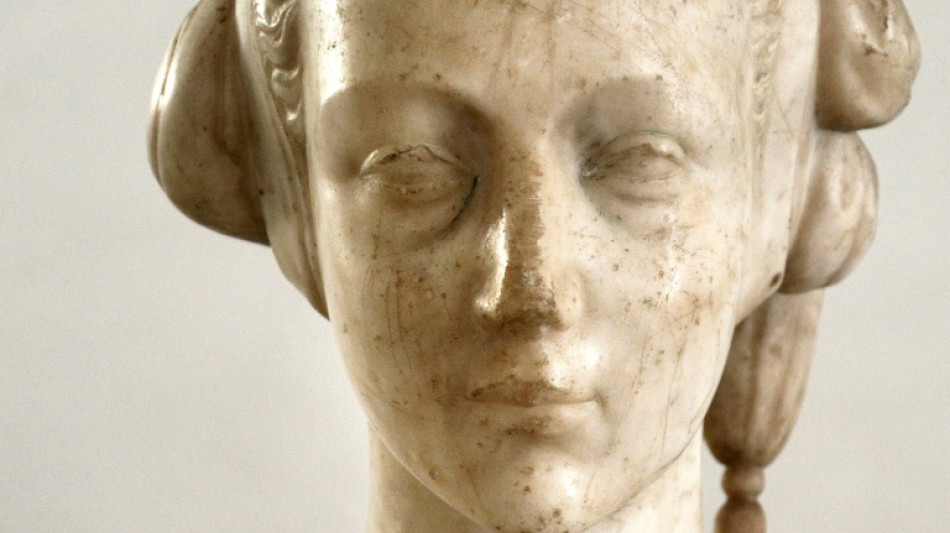

Bust attributed to Donatello splits Slovakia
A bust attributed to Renaissance master Donatello re-emerges in Slovakia after falling into obscurity following World War II, but the country’s nationalist government sparks anger by squirrelling it away in a ministry building.
The sculpture of Italian noblewoman Cecilia Gonzaga spent centuries in a manor house in central Slovakia, whose owners, the noble Csaky family, left it behind when they fled the advancing World War II front in 1945.
Moved about and ultimately forgotten in the aftermath, it was sitting in a depository at the Spis Museum in the eastern town of Levoca when art historian Marta Herucova stumbled across it.
The bust had been marked "unknown author". But Herucova noticed the base was inscribed with the words: "Ceciliae Gonzagae opvs Donatelli" (Cecilia Gonzaga, a work by Donatello).
If confirmed, it would be only the eighth artwork signed by the Italian Renaissance sculptor discovered worldwide.
Herucova made the find in 2019, but it was only announced in February -- surprising the country.
"Who would expect an original Donatello to appear in Slovakia?" former museum director Maria Novotna told AFP.
But the bust is now a subject of controversy.
Nationalist Culture Minister Martina Simkovicova decided to remove it from the museum and bring it to an unknown location in late May, citing security.
The move dismayed critics and art historians, who say the bust needs expert conservation and research to confirm if it is really by Donatello (1386-1466).
- War story -
The bust has an epic backstory.
After the Csaky family fled, Soviet troops looted their house, which then became a juvenile detention centre for girls after the communist government took over former Czechoslovakia in 1948.
The girls played with the bust and even defined its eyes with blue pen, said Peter Cizmar, the son of a former guardian.
In 1975, artwork still surviving at the centre was moved to the nearby Spis Museum.
Attributed to an unknown 19th-century artist, the bust "was put in a depository and had not left it since", said former director Novotna, an art historian.
Novotna was in charge of the museum catalogue as a young worker, and now bemoans a lack of time for research as she was swamped with work.
- Dinner companion -
In 2019, Herucova was working on the museum's 19th-century collection when she found the piece.
"The bust just came up," she said.
After noticing the inscription, she started in-depth research.
She suspected forgery, but the material, details and inscription were all too telling, she said.
"Even artists who made Renaissance-style busts never signed them in the name of the original author," Herucova told AFP.
She wrote about the finding in the French art history magazine Revue de l'Art, waiting for someone to contest the bust's origin -- which has not happened.
Herucova also contacted Count Moritz Csaky, who had no clear recollection of its origin either, as his family left for Vienna when he was 11.
But he did recall seeing the bust placed on the porch, where the family dined in summer.
"He said there used to be two original Gothic statues next to it, which are also in the museum today," Herucova said.
- 'Safe and protected' -
Herucova also contacted Italian art history professor Francesco Caglioti, who voiced doubt about the authorship but declined to elaborate.
She is now pinning hopes on research in cooperation with foreign institutions.
But for now, the bust is hidden away.
Simkovicova, the culture minister who ordered it be moved with the help of a police commando, said it was "now safe and protected".
Police chief Jana Maskarova later said the bust was at an interior ministry centre in Topolcianky, central Slovakia.
Simkovicova promised to display the bust when "conditions are favourable".
Herucova hopes the ministry will not try to revamp the bust, which should retain its patina, she said.
"It's supposed to go to a professional place where they know how to do lab analyses."
- Emancipated noblewoman -
Research suggests the bust was made when Cecilia Gonzaga (1426-1451) became engaged to influential politician Oddantonio da Montefeltro.
Her father made the match, seeking to bolster relations between the families, but the well-educated Cecilia chose a life in a convent over marriage.
It is known that Cecilia's brother commissioned artworks from Donatello.
The Gonzagas later fostered strong ties with the imperial court of Vienna and were united by marriage with the Csaky family.
Some studies suggest the bust was made after Cecilia became a nun, possibly based on an earlier coin bearing her likeness.
Novotna said she believed the bust was Donatello's work.
"But we need further research, and precisions and evaluations will definitely be made in the decades to come. You don't find works like this every day, do you?"
P.Mueller--MP




